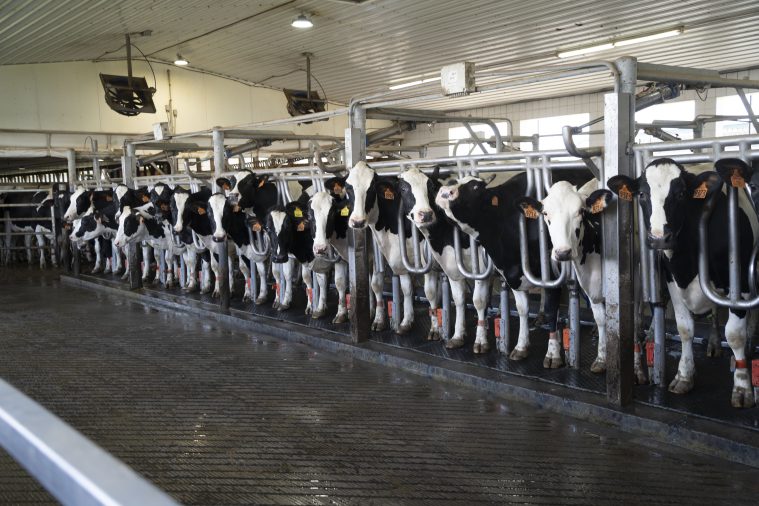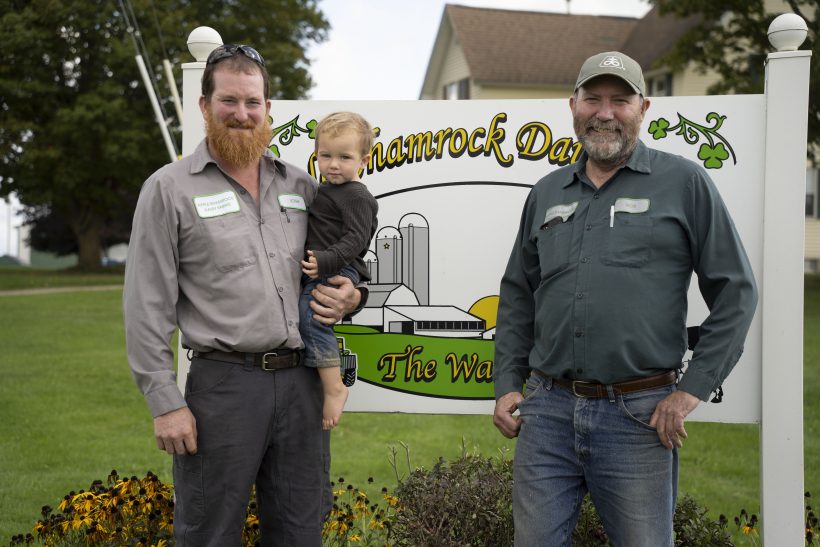Story by William Whisler
Video by David Varner
Located in the small town of Townville in Crawford County, Apple Shamrock Dairy Farm has been in the Waddell family for almost 50 years.
The dairy is one of Crawford County’s largest farms, where Rob Waddell and his son Josh manage the 1,100-cow dairy that ships 120,000 pounds (or 13,900 gallons) of milk to Rothenbuhler Cheesemakers in Middlefield, Ohio, to make Swiss cheese.
For years, the Waddells, who grow 3,500 acres of crops to feed their dairy herd, have been hit hard by diminishing crop yields that have led to significant, recurring financial loss. The biggest culprit for their losses has been Pennsylvania wildlife – white tailed deer in particular.
“One of the things that’s been growing more and more each year is the amount of deer damage that we are getting,” Josh Waddell said. “It’s to the point where it is starting to make management decisions for us as far as what crop we can grow in what field.”
The issue is not unique to the Waddells. Crop damage has continually been identified as a key concern to Pennsylvania farmers and Pennsylvania Farm Bureau marked working on issues to mitigate the effects of crop damage caused by wildlife as one of its top priorities for 2023.
Crop damage from wildlife has grown in recent years, and Pennsylvania ranks as one of the nation’s top states suffering from crop damage directly tied to wildlife, according to data from the United States Department of Agriculture (USDA).
USDA estimates from federal crop insurance data that Pennsylvania suffered north of $20 million in losses on corn in 2017 – the highest reported number in the nation. That same study showed that Pennsylvania farmers suffered north of $15 million in losses to soybean crops in 2017.
The Waddells have seen those losses first-hand. Under normal circumstances without significant deer damage, the Waddells average yield on grain corn should come out to be between 160-170 bushels per acre. Reality shows that the yield is nowhere near the number.
“On our farm, when we get into typical crop damaged fields, our mean or average yield on grain corn is a very easy thing to weigh. Our average yield would be a 160–170-bushel average,” Josh Waddell said. “One thing that we have found now that we have a combine that actually tracks yield and makes maps, is that our outside yield of our field is averaging anywhere between 60-to-90 bushels per acre. When you start looking and monetizing that, that is your biggest round. We did not realize how much damage we actually had until we got this combine that was actually tracking our yield damage.
“I would say on the outside 24 rounds of our cornfields, we are at 50 percent yield, at best,” Waddell added. “Then when we started looking at where we can grow specific crops, if you want to talk about soybeans in particular, out of our 3,500 acres there are 1,000 acres that we can’t even grow soybeans on anymore because our yield would be zero.”
Monetarily speaking, in just one small eight-acre section of soybeans, Waddell’s average yield should be around 80 bushels per acre. In reality, his yield was expected to be 15 bushels per acre. With a bushel of soybeans costing $13 and a 65 bushel per acre loss, just one eight-acre section of field would result in a loss of more than $6,700.
The Waddells plant excess crops to be able to feed their herd and then sell the excess crop, but depending on yields, that is not always possible, which also results in lost revenue. To Waddell, the biggest impact that wildlife plays on his farm is related to the family’s crop selection.
“The main affect for us is where we can and can’t grow crops. As far as running us short on grain corn, our dairy is unique because we have row crops as well as crops to feed the cows, so we will chop enough feed to feed the cows and then sell the excess. There is definitely lost revenue there by not selling the excess. But the bigger thing for us is that it makes our crop rotation very difficult. Knowing we only grow some crops in one field and other crops in other fields is probably the biggest challenge that I have. At the end of the day when we grow a crop of soybeans or if we leave a field of corn to shell and there’s nothing there, we learn pretty fast that we will only do that one year.”

Losses aren’t always easy to see from the outside of a field either. Farmers often face dead zones within their fields that are completely eaten up by deer or even caused by a bear rolling around inside the field.
“We kind of call them party zones. When we’re chopping or harvesting corn we will hit these spots – not only on the edges – which is what a lot of people can’t see, is just how much damage there is in the middle. But you can look around and see plants have been eaten clear off,” Waddell said. “There are no ears or some ears that are eaten off. The corn is probably twice or three times as high in areas where the corn is good, but you will find spots where the corn didn’t canopy and there is grass coming in. That has a huge impact to our yield even more so than the outside edges.”
The reality is that the significant financial strain caused by increased crop damage forces many farmers to have to make tough financial decisions, which for many includes getting out of the business altogether.
Even off the farm, it’s hard to drive anywhere in the rural parts of Pennsylvania and not pass a deer carcass on the side of the road, as the number of car accidents directly tied to deer are rapidly growing across the Commonwealth.
A national study conducted by State Farm Insurance Company reported that 1.8 million auto insurance claims were filed nationwide between July 1, 2022, and June 30, 2023. Of those claims 153,397 claims came from Pennsylvanians – the highest number in the nation. That same study noted that Pennsylvania drivers had a 1 in 59 chance of getting into an accident involving wildlife – the third highest mark in the country.
PennDOT data shows that there were 5,848 accidents in the state that were directly or indirectly caused by deer. At least 1,264 people were injured and nine people were killed in those crashes.
Pennsylvania Farm Bureau Wildlife and Fisheries Committee chair Andy Bater has noted how crop damage has impacted farmers across the state and that finding adequate solutions can be difficult.
“Crop damage is a huge issue for farmers in Pennsylvania. As a matter of fact, farming in Pennsylvania suffers more damage to certain crops than almost anywhere else in the nation,” Bater said. “We are aware of significant issues with crop insurance claims, and we are aware of significant loss of crops like sweet corn, pumpkins, flowers, you name it.”
Bater has also experienced crop damage on his own farm. Bater, who lives in the town of Julian, in Centre County, has 50 acres that are fenced in, predominantly to protect natural areas that he is attempting to regenerate for endangered warblers that come from South America over the summer months each year.
“The area inside the fence is abundant with natural regeneration. There are tree seedlings coming up, and it is a future forest that will be beneficial to all types of wildlife,” Bater said. “Outside our fence you can see that the deer have eaten everything off. There’s very little regeneration, very few seedlings. This issue of wildlife damage is not just a factor for agriculture, but for Pennsylvania’s wildlife areas in general.”
While current programs in place in Pennsylvania to aid farmers including the Red Tag and DMAP programs are beneficial, farmers have long noted that the programs are not enough to serve as an adequate solution to the problem. Bater, in testimony to Pennsylvania’s Senate Game and Fisheries Committee on Oct. 23, noted that a decline in “experienced, qualified and respectful” hunters to help manage the deer population has also been a challenge.
Waddell stated that he has considered fencing as a possible solution to try to mitigate crop damage, but due to the cost of serviceable deer fencing, he doesn’t know if it is feasible or not.
“When I think about crop damage, one of the things that’s really been coming to mind for me is fencing. Fencing is expensive, but I think if you want to collect some more data and truly learn the extent of the problem, fencing seems to be a solution for me,” Waddell said. “Fencing I think would really illustrate that when we take the food away from the animals, and then private landowners and the Game Commission sees how detrimental the deer can be to forests, then I think the whole community will wake up and say that we have a problem.”
While there isn’t one clear-cut solution to the problem, Pennsylvania Farm Bureau is actively working with its state and federal legislators to try to find a multi-pronged solution that can make a positive impact for farmers.
In the meantime, Waddell urges consumers to know that crop damage doesn’t just affect farmers, it also impacts consumers at the grocery store.
“At the end of the day, this not only affects me, but it affects you at the grocery store,” Waddell said. “Whatever affects me, affects everybody. It trickles down. If you’re not in agriculture but see deer damage and think that it doesn’t affect you, at the end of the day it actually does, because it moves agriculture trends differently and increases our cost of production. When our cost of production goes up, everything goes up across the board. It’s something that affects the entire population.”

